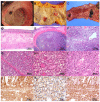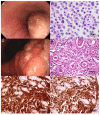Primary Gastrointestinal T/NK Cell Lymphoma
- PMID: 34072328
- PMCID: PMC8199162
- DOI: 10.3390/cancers13112679
Primary Gastrointestinal T/NK Cell Lymphoma
Abstract
Primary gastrointestinal T/NK cell lymphoma (GI-TNKL) is an uncommon and heterogeneous group of lymphoid malignancies. We aimed to investigate their subtype distribution, clinicopathologic characteristics, and clinical outcomes. A total of 38 GI-TNKL cases and their clinical and pathological characteristics were analyzed. GI-TNKL occurred in adults with a median patient age in the sixth decade of life and showed a slight male predominance. The most common histologic type was extranodal NK/T-cell lymphoma, nasal type (ENKTL; 34.2%), followed by monomorphic epitheliotropic intestinal T-cell lymphoma (MEITL; 31.6%), intestinal T-cell lymphoma, NOS (ITCL, NOS, 18.4%), anaplastic large cell lymphoma, ALK-negative (ALCL, ALK-; 13.2%). The small intestine was the primary affected region. More than 90% of patients complained of various GI symptoms and cases with advanced Lugano stage, high IPI score, or bowel perforation that required emergent operation were not uncommon. GI-TNKL also showed aggressive behavior with short progression-free survival and overall survival. This thorough clinical and pathological descriptive analysis will be helpful for accurate understanding, diagnosis, and treatment.
Keywords: T/NK cell lymphoma; clinicopathologic features; gastrointestinal tract; intestinal lymphoma.
Conflict of interest statement
The authors declare no conflict of interest.
Figures




Similar articles
-
The spectrum of intestinal mature T- and NK-cell neoplasms in a tertiary center in Taiwan with a high frequency of perforation.Pathol Res Pract. 2022 Dec;240:154184. doi: 10.1016/j.prp.2022.154184. Epub 2022 Oct 20. Pathol Res Pract. 2022. PMID: 36327820
-
Intestinal T-cell and NK/T-cell lymphomas: A clinicopathological study of 27 Chinese patients.Ann Diagn Pathol. 2018 Dec;37:107-117. doi: 10.1016/j.anndiagpath.2018.10.004. Epub 2018 Oct 9. Ann Diagn Pathol. 2018. PMID: 30317149
-
T- and NK-cell lymphoproliferative disorders of the gastrointestinal tract: review and update.Pathology. 2020 Jan;52(1):128-141. doi: 10.1016/j.pathol.2019.10.001. Epub 2019 Nov 11. Pathology. 2020. PMID: 31727264 Review.
-
Gastrointestinal T- and NK-cell lymphomas and indolent lymphoproliferative disorders.Semin Diagn Pathol. 2020 Jan;37(1):11-23. doi: 10.1053/j.semdp.2019.08.001. Epub 2019 Aug 28. Semin Diagn Pathol. 2020. PMID: 31522873 Review.
-
[Clinicopathologic study of 963 cases of mature T-cell and natural killer/T-cell lymphoma with respect to 2008 WHO classification of lymphoid neoplasms].Zhonghua Bing Li Xue Za Zhi. 2010 May;39(5):291-5. Zhonghua Bing Li Xue Za Zhi. 2010. PMID: 20654150 Chinese.
Cited by
-
A rare case of monomorphic epitheliotropic intestinal T-cell lymphoma, presenting with spontaneous intestinal perforation.Int J Surg Case Rep. 2024 Nov;124:110485. doi: 10.1016/j.ijscr.2024.110485. Epub 2024 Oct 20. Int J Surg Case Rep. 2024. PMID: 39447336 Free PMC article.
-
The CT findings of extranodal natural killer/T-cell lymphoma, nasal type involving the gastrointestinal tract.Eur Radiol. 2025 Aug;35(8):4932-4944. doi: 10.1007/s00330-025-11369-8. Epub 2025 Jan 29. Eur Radiol. 2025. PMID: 39878902
-
Clinical and Histopathological Features of an Italian Monocentric Series of Primary Small Bowel T-Cell Lymphomas.Cancers (Basel). 2023 May 13;15(10):2743. doi: 10.3390/cancers15102743. Cancers (Basel). 2023. PMID: 37345080 Free PMC article.
-
A Rare Case of Gastric Extranodal NK/T-Cell Lymphoma With Orbital Involvement.ACG Case Rep J. 2024 Feb 28;11(3):e01280. doi: 10.14309/crj.0000000000001280. eCollection 2024 Mar. ACG Case Rep J. 2024. PMID: 38425941 Free PMC article.
-
Primary Gastrointestinal T-Cell Lymphoma and Indolent Lymphoproliferative Disorders: Practical Diagnostic and Treatment Approaches.Cancers (Basel). 2021 Nov 18;13(22):5774. doi: 10.3390/cancers13225774. Cancers (Basel). 2021. PMID: 34830926 Free PMC article. Review.
References
-
- Kim S.J., Choi C.W., Mun Y.-C., Oh S.Y., Kang H.J., Lee S.I., Won J.H., Kim M.K., Kwon J.H., Kim J.S., et al. Multicenter retrospective analysis of 581 patients with primary intestinal non-hodgkin lymphoma from the Consortium for Improving Survival of Lymphoma (CISL) BMC Cancer. 2011;11:321. doi: 10.1186/1471-2407-11-321. - DOI - PMC - PubMed
-
- Kim J.-M., Ko Y.-H., Lee S.-S., Huh J., Kang C.S., Kim C.W., Kang Y.K., Go J.H., Kim M.K., Kim W.-S., et al. WHO Classification of Malignant Lymphomas in Korea: Report of the Third Nationwide Study. Korean J. Pathol. 2011;45:254–260. doi: 10.4132/KoreanJPathol.2011.45.3.254. - DOI
-
- Swerdlow S.H., Campo E., Harris N.L., Jaffe E.S., Pileri S., Stein H., Thiele J., Swiatowa Organizacja Zdrowia. International Agency for Research on Cancer . WHO Classification of Tumours of Haematopoietic and Lymphoid Tissues. Revised 4th ed. International Agency for Research on Cancer; Lyon, France: 2017.
LinkOut - more resources
Full Text Sources

